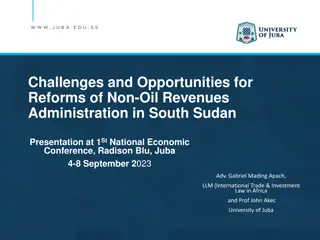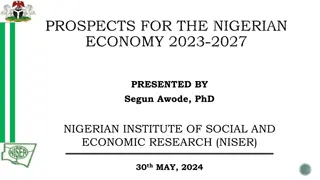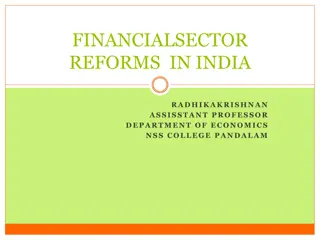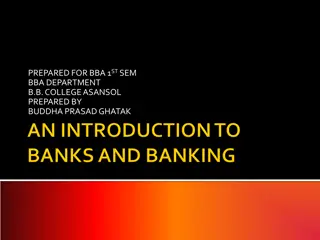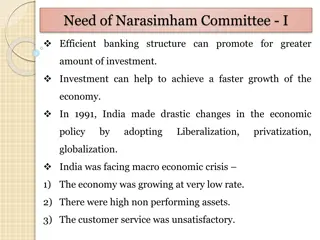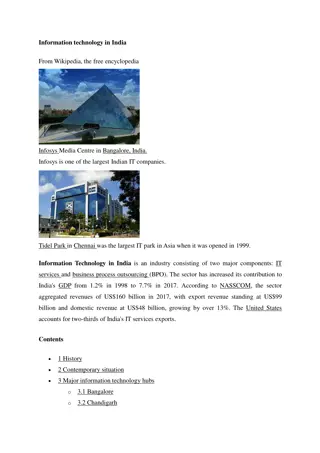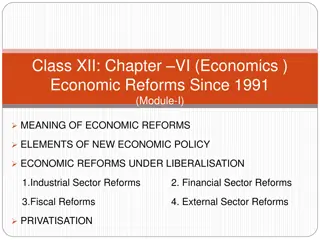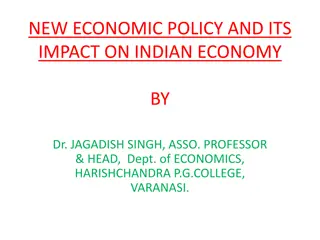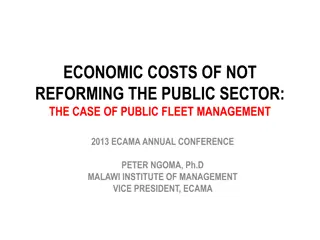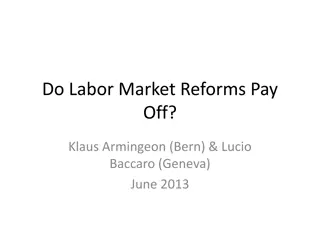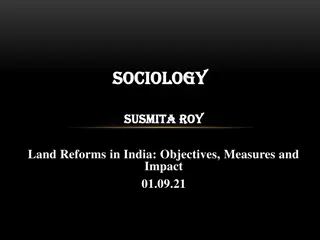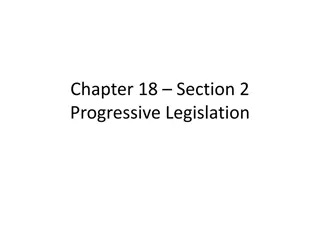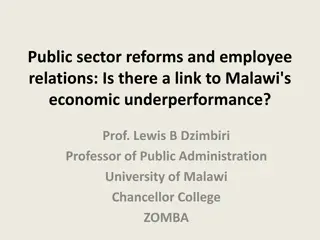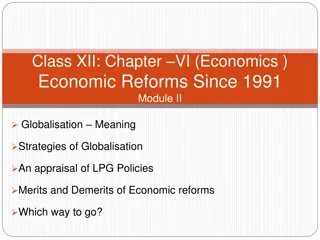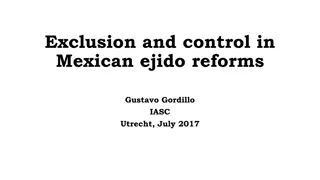Overview of Economic Reforms in India Since 1991
The New Economic Policy (NEP) in India since 1991 focused on liberalization, privatization, and globalization to enhance competitiveness, productivity, and efficiency. The policy aimed to address challenges like unsatisfactory public sector performance, high inflation rates, debt burdens, and balance of payment issues. It involved phases of liberalization, privatization, and globalization with measures to stabilize and reform the economy. Liberalization efforts included removing controls, permits, licenses, and duties to encourage industrial growth and foreign investment.
Download Presentation

Please find below an Image/Link to download the presentation.
The content on the website is provided AS IS for your information and personal use only. It may not be sold, licensed, or shared on other websites without obtaining consent from the author.If you encounter any issues during the download, it is possible that the publisher has removed the file from their server.
You are allowed to download the files provided on this website for personal or commercial use, subject to the condition that they are used lawfully. All files are the property of their respective owners.
The content on the website is provided AS IS for your information and personal use only. It may not be sold, licensed, or shared on other websites without obtaining consent from the author.
E N D
Presentation Transcript
CHAPTER 3 ECONOMIC REFORMS IN INDIA SINCE 1991 New Economic Policy (NEP) refers to the efforts made through different policy decisions and changes that were made to create competitive environment and increase in productivity and efficiency. The broad components of NEP are LPG in place of LPQ * Liberlisation in place of Licensing, * Privatisation in place of Quotas, * Globlisation in place of Permits.
1. Need for Economic Reforms Problems facing Economy (i) Unsatisfactory performance of public sector, (ii) High rate of inflation, (iii) Increasing debt burden, (iv) Problem of balance of payment.
1.2 Immediate crisis (i) Gulf crisis, (ii) Inadequate Foreign Exchange Reserves. 1.3 Measures (i) Stablization Measures (ii) Structural Reforms Measures
2. Main components of New Economic Policy (i) New Industrial Policy, (ii) New trade policy, (iii) New fiscal policy, (iv) New monetary policy, (v) New investment policy, (vi) Globalisation of finance.
3. Main Phases of New Economic Policy (i) Liberalisation, (ii) Privatisation, and (iii) Globalisation.
4. LIBERLISATION Liberalisation means removing all unnecessary controls and restrictions like permits, licenses, protectionist duties, etc., imposed by the government
4.1 Measures adopted for Liberalisation (A) Soft Liberalisation policy (1985-1991) The era of liberalisation started with the period of Rajiv Gandhi, the then Prime Minister, in 1985. In this period of modernization, a large number of incentives and exemptions were granted.
(B) Extensive Liberalisation Policy [After 1991 period] (i) Liberalised licensing policy, (ii) Expansion of industries, (iii) Concession from Monopolies, (iv) Extending investment limits for small industries, (v) Free import of machinery and Raw materials, (vi) Freedom to import technology, (vii) Freedom to financial institution, (viii) Reduction in Tax rates.
4.2 Industrial Sector Reforms (i) Abolition of Industrial Licensing, (ii) Decrease in role of Public Sector, (iii) De-reservation of Production by SSI, (iv) Price Determination by market forces, (v) Freedom to Import Capital Goods, (v) Expansion of Production Capacity.
4.3 Financial Sector Reforms (i) Role of RBI changed from Regulator to Facilitator, (ii) Establishment of Private Sector Bank, (iii) Foreign Investment, (iv) Setting up New Branches.
4.4 Tax Reforms / Fiscal Sector Reforms (i) Reduction in Direct Taxes, (ii) Reform in Indirect taxes, (iii) Simplification of Tax Paying Procedure, (iv) Goods and Service Tax.
4.5 External Sector Reforms / Foreign Exchange Reforms / Foreign Trade Reforms (i) Devaluation of Rupee, (ii) Determination of Foreign Exchange Rate Market Forces.
4.6 Trade and Investment Policy reforms (i) Dismantling of Quantitative Restriction on Imports and Exports, (ii) Reduction of Tariff Rates, (iii) Removal of Licensing Procedure for Imports, (iv) Removal of Export Duties.
5. PRIVATIZATION Transfer of ownership from government to private sector of organisations which am presently run and controlled by government.
5.1 Measures of Privatisation (A) Ownership Measures (i) Total De-Nationalisation, (ii) Joint venture. (B) Organisational Measures (i) HoIding company, (ii) Leasing, (iii) Disinvestment.
5.2 Factors encouraging privatisation in India (i) New Economic reforms programmes, (ii) Increasing debt burden on government, (iii) Presence of foreign companies, (iv) To make Indian companies more competitive, (v) Broad base for increasing production.
5.3 Steps of Indian Economy towards privatization (i) Contraction of Public sector, (ii) Participation of private sector, (iii) Abolition of Industrial licensing, (iv) Improvement by MOU, (v) Re-organisation of public sector, (vi) Disinvestment of equity of public sector,
(vii) Establishment of National Renewable fund, (viii) Removal of investment control on big houses, (ix) Policy related to sick units, (x) Sale of shares of public sector undertaking
5.4 Arguments in favour of Privatisation (i) Reduction in Budgetary Deficit, (ii) Less political intervention, (iii) Improvement in economic efficiency and technical efficiency, (iv) Increased accountability, (v) Globalisation of economy, (vi) Sources of new job, (vii) Increase in industrial growth, (viii) Increase 1n foreign investment, (ix) In line with international trade, (x) Encouragement to new Inventions.
5.5 Arguments Against Privatisation (i) Concentration of economic power, (ii) Substitution of monopoly power. (iii) Lop-sided development of industries, (iv) Industrial sickness, (v) Entry of multinationals, (vi) No safety for the weaker sections, (vii) Social institutions, (viii) Corruption.
6. GLOBLISATION Globalisation may be defined as a process associated with increasing openness, growing economic interdependence and deepening economic integration in world economy. In short, integrating the economy of the country with the world economy.
6.1 Factors fostering Globalisation in India (i) Technical changes, (ii) Competition, (iii) Liberalisation policies, (iv) Emergence of United states as a super power, (v) Experiences of Developing countries, (vi) Other factors
6.2 Policy Measures adopted Under Globlization (i) Rise in equity limit participation of foreign investment, (ii) Devaluation of Rupee, (iii) Convertibility of Indian rupee, (iv) Removal of controls on foreign trade, (v) Modification of Tariffs, (vi) Modification in technology agreements.
6.3 Effects of Globalisation (A) Favourable Effects (i) Increasing share of exports in world trade, (ii) Favourable effect on Export-Import Ratio, (iii) Application of high technology, (iv) Stable and strong exchange rate.
(B) Adverse Effects (i) Decrease in Revenue of Indian Industries, (ii) Increasing share in capital and management by foreign entrepreneurs, (iii) Increasing Regional disparities, (iv) Export of Profit.
6.4 Suggestions Regarding Globalisation (i) Improvement in Competitiveness of Indian producers, (ii) Alliance with MNCs, (iii) Self-sufficiency in Technology, (iv) Facing International protectionism, and (v) Modernisation of Agriculture and small sector.
7. AN APPRISAL OF LPG POLICIES 7.1 Merits of LPG Policies Following observations highlights the merit of LPG policies (i) Vibrant Economy, (ii) Stimulate to Industrial Production, (iii) A Check on Fiscal deficit, (iv) A Check on Inflation, (v) Consumer s Sovereignty, .
(vi) A Sustainable Increase in ForEx Reserve, (vii) Flow of Private Foreign Investment, (viii) Recognition of India as an Emerging Economic Power, (ix) A Shift from Monopoly Market to Competitive Market
7.2 Demerits of LPG Policies Following observations highlights the demerit of LPG policies (i) Neglect of Agriculture, (ii) Urban Concentration of Growth Process, (iii) Economic Colonialism, (iv) Spread of Consumerism, (v) Lopsided Growth Process, (vi) Cultural Erosion.
8. Outsourcing Outsourcing means obtaining goods and services by contract from an outside source.
9. World Trade Organisation From January 1, 1995, WTO has been working. It replaced the GATT(General Agreement on Trade and Tariff), established in 1948 with 23 countries. The WTO acts as a permanent watch dog of international trade. 9.1 The objective of WTO (i) To enlarge production and trade of services, (ii) To ensure optimum utilization of world resources, (iii) To protect the environment.
9.2 Role of WTO (i) Establish a rule based trading regime in which nations cannot place arbitrary restrictions on trade, (ii) To promote free trade in the international market by reducing tariff and non-tariff barriers. (iii) To felicitates bilateral and multi lateral trade agreements. (iv) It is focusing in the competition in the international market and free access to market across different countries of the world.
10. Achievements of LPG Policies (i) Rise in GDP growth, (ii) Rise in Foreign exchange reserves, (iii) Control of inflation, (iv) Rise in flow of foreign capital, (v) Rise in competitiveness of industrial sector, (vi) Rise in integration with the world economy.
11. Demonetisation It is the process of stripping a currency unit from its status as legal tender in the country. Demonetisation results m change in national currency. The present currency in circulation is pulled off and new currency is circulated.
11.1 Types of Demonetisation (i) Total Demonetisation (ii) Partial Demonetisation
11.2 Purposes sought by Demonetisation (i) Stripping corruption (ii) Combating inflation (iii) Curbing counterfeit currency (iv) Combating tax evasion (v) Increasing performance of economy
11.3 History of Demonetisation in India (i) On 12/01/1946 all notes of denominations of Rs. 500 and Rs. 1000 were demonetised with a time limit of 10 days to exchange demonetised notes. Its purpose was to catch tax evaders. (ii) On 16/01/1978 all notes of denominations of Rs. 1000, Rs. 5000 and Rs. 10000 were demonetised with a time limit of 3 days to exchange demonetised notes. Its purpose was to catch corrupt leaders and officials in predecessor governments. (iii) On 08/11/2016 all notes of denominations of Rs. 500 and Rs. 1000 were demonetised with a time limit of 50 days in exchange demonetised notes from banks and some essential service stores.
11.4 Demonetisation of 2016 (i) On 8 November 2016, the Government of India announce that the demonetization of all Rs. 500 and Rs, 1000 banknotes of the Mahatma Gandhi series. (ii) Rs. 500 (new series) and Rs. 2000 notes were introduced. (iii) 50 days time limit given for exchange of demonetised notes. (iv) Limits were put on exchange per day and withdrawal per day (and week) during this time. (v) Mixed reaction by public but strongly criticized by Opposition.
11.5 Effects of 2016 Demonetisation (1) Pushed India towards cashless economy (ii) Raised tax payments (iii) Brought an end to black money (iv) Curbed terrorist funding (v) Curbed effect on growth and revenues of MSMEs
12. GOODS AND SERVICE TAX (GST) Objectives of GST (i) To eliminate the cascading impact of taxes on production and distribution coat of goods and services. (ii) Streamlining indirect tax regime (iii) Growth of revenue in States and Union Territories (iv) Reduction in transaction costs and unnecessary wastage (v) Elimination of the multiplicity of taxation (vi) One Point Single Tax (vii) Reduction in average tax burdens (viii) Reduction in the corruption
12.2 Types of GST laws (i) At a centre level called Central GST (CGST) (ii) At the state level State GST (SGST)
12.3 Benefits of GST (i) GST provides comprehensive and wider coverage of input credit setoff, you can use service tax credit for the payment of tax on sale of goods etc. (ii) Many indirect taxes in state and central level have been included by GST. You need to pay a single GST instead of all. (iii) Uniformity of tax rates across the states.
12.3 Benefits of GST (iv) Ensure better compliance due to aggregate tax rate reduction. (v) By reducing the tax burden, the competitiveness of Indian products in international market has increased and there by development of the nation. (vi) Prices of goods are expected to reduce in the long run as the benefits of less tax burden would be passed on to the consumer.



